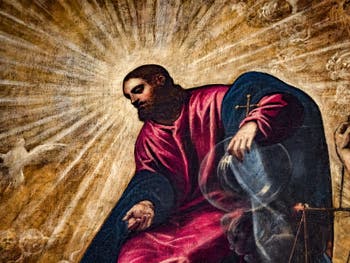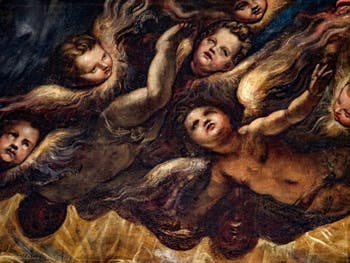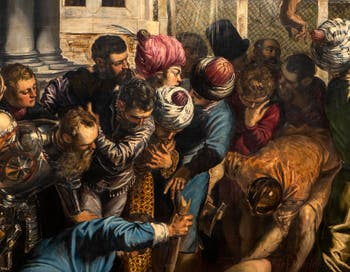Art Painters | Music | Literature | Video | Pictures
Painters Tintoretto | Titian | Canaletto | Fortuny | Albrecht Dürer |
Tintoretto Life and Career | Colors and Fame | Kings Churches Museums
The Tintoretto: a selfless man
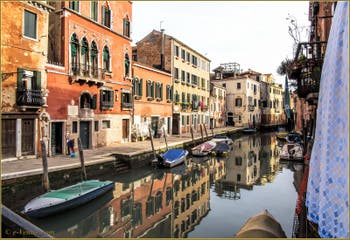
Tintoretto's Palazzo In 1575, the Council of Ten decided to allocate a vacant senseria to Tintoretto.
The senseria was an annual pension of one hundred ducats granted to artists, thanks to the annual patent of one hundred gold ducats paid to the Serenissima by the Germans of the Fondaco dei Tedeschi.
Tintoretto had not asked for this favour. To remove any pretext for refusing it, the Ten had the good idea of placing it on the heads of his children.
Here is what the document says:
“On 27 September 1574, in the Council of Ten, assisted by [... ]
For the price of the painting of our happy victory (the battle of Lepanto), executed by our faithful Jacques Robusti, known as the Tintoretto, and of the other paintings he proposes to do for us in the future, without any other payment than that of the canvases and colours, according to the commissions he will receive from this Council, we want him to be given the expectation of the first senseria vacant in the Fondaco dei Tedeschi, following those we have already granted, for the maintenance of his family, which annuity will be carried in the name of his sons, daughters or nephews, as he sees fit.
Of the 30 votes cast, 25 were in favour, 3 against and 2 abstentions”
A Simple Man and a loving father
Tintoretto lived in the Sestier of Canareggio.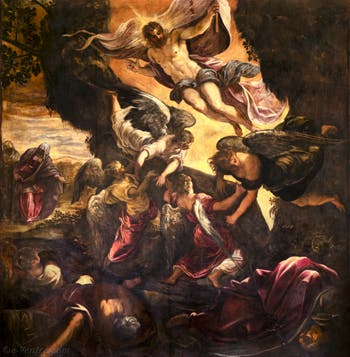
The Resurrection of Christ In 1574, Tintoretto bought his house, where he had already been a tenant for some years.
This house is located at n° 3399 of the Fondamenta dei Mori, where he died on 31 May 1594.
At the time, there were mainly warehouses for goods and the inhabitants were mainly craftsmen.
In 1550 he had married Faustina Episcopi daughter of Marco Episcopi, elected Guardian Grande of the Scuola di San Marco in 1547.
Three of their children were painters: Marco, Domenico and Marietta, his favourite daughter who combined musical talent with her portrait painting skills.
His daughter Marietta's features can be found in several of Tintoretto's works.
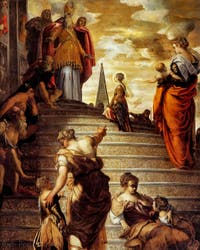
Presentation of the Virgin At the Church of the Madonna dell'Orto, close to Tintoretto's home, you can admire one of his most beautiful paintings The Presentation of the Virgin in the Temple.
The little Mary climbing the stairs is Marietta.
At the Doge's Palace, he depicted himself and Marietta among the crowd in the huge painting of Paradise that adorns the Great Council Chamber.
Tintoretto and music
Tintoretto, who loved music and singing, gave concerts at his home, attended by Marietta and Joseph Zarlino of Chioggia, a talented musician.According to Vasari, Tintoretto could play several instruments.
When painting the Wedding at Cana, Paul Veronese shows us Tintoretto playing the violin:
“Paul depicted the most famous Venetian painters performing a concert au naturel.
In front of the painting, in the void inside the triclinium, the Titian plays the bass; Paul plays the viol; Tintoretto the violin, and Bassan the flute, by which he meant to allude to the profound science and slow, wise execution of the Titian, to the brilliance and pleasantness of Paul, to the speed of Tintoretto, and to the suavity of Bassan.”
Charles de Brosses - Familiar letters 1739-40
Tintoretto: Michelangelo's Drawing and Titian's Colour
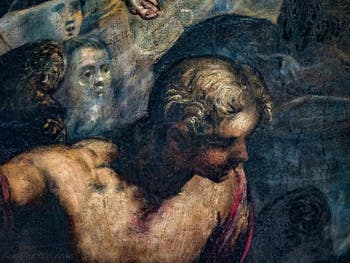
Tintoretto's Paradise
“He sought, instead, to make himself head of a new school that perfected that of Titian and joined in his own way what it lacked.
A vast idea, in which we recognise a great soul, who redoubled his courage for having been driven from the Titian, instead of losing him.
Forced by his current fortune to live in an extremely simple room, he wrote in it: “Michelangelo's drawing and Titian's colouring”.
He constantly copied Titian's works. He had obtained, at considerable expense, the plaster casts of Michelangelo's statues in Florence; he studied them day and night. He added plaster casts of many antique statues and bas-reliefs.
He often drew his models by torchlight to obtain strong shadows and thus become accustomed to great chiaroscuro.
Tintoretto's Paradise With the same aim in mind, he made models in wax and clay and after covering them with clothes, with great care, he placed them in small houses that he built with pieces of cardboard and wooden rulers.
Outside his little house he would place a lamp whose light would shine in through the windows. By varying the position of his little models, he could observe the different effects of the sunlight.
He hung these same models from the ceiling of his room in different attitudes and thus drew them from different points of view in order to acquire a knowledge of sotto-in-su, in which the Venetian School was much weaker than the Lombard one.
He did not forget anatomy and avidly seized every opportunity to draw nude figures in various positions and under various foreshortenings, to be able one day to give his compositions the variety of nature.
Thus, deprived of a master, he nonetheless followed the best method of learning to draw.
He began by drawing the forms of antiquity and with his imagination full of these beautiful contours, he drew the nude and sought to correct its defects.
Tintoretto's Paradise Tintoretto added to this excellent method of studying what historians call the most terrible genius that painting has ever had, an imagination always rich in new ideas, a fire that made him conceive the strongest characters of the passions and that did not leave him until he had expressed them on canvas down to their smallest details.”
Stendhal - Venice school of painting
At first, Tintoretto made a name for himself by executing portraits in the manner of Titian
He also made himself appreciated by distributing his sketches to his friends, and by not hesitating to invite those whose faces he liked to come and pose for a free portrait!
This generosity brought him publicity, as people began to talk more and more about the man nicknamed il Tintoretto.
And it also became apparent that he had mastered Titian's style to such an extent that some people were mistaken... But this was just one stage in the work of this man, for whom living and painting were one and the same in his passionate and generous creative impulse.
Jacopo Robusti Tintoretto: the colours of Schiavone, Learning large and small format
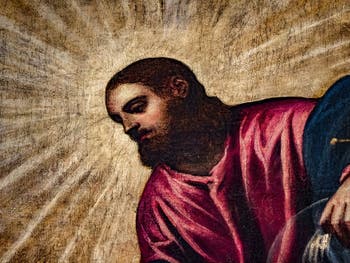
Tintoretto's Paradise In his youth, his energy and his need to constantly perfect his art were not satisfied by his work in the studio alone, which was nonetheless considerable. He found the means and the pleasure of painting in all the forms that his studio could not offer him elsewhere.
Sometimes he helped painters who painted and decorated furniture. Thus the Suzanne in the Barbarigo house, featuring a large number of small animals and all the things that made a place charming in a small space, reveals his talents as a miniature painter.
He also sometimes followed masons he knew well to their building sites on the mainland “to paint frescoes on newly-built walls, without receiving any pay. It was an excellent way of practising large-scale painting.
Schiavone's colours
He also worked with Schiavone, a painter capable of beautifully imitating natural colours, who taught him a great deal and whom he considered a great colourist.
Tintoretto's Paradise However, he added: “Painters should imitate Schiavone's colour, but they would be very wrong not to draw better than he.”
He imitated him so well with his Circumcision in the Church of the Carmini, that some attributed it to Schiavone!
Later, Tintoretto never failed to offer Schiavone's services when he failed to secure commissions.
When Tintoretto finally felt capable of producing large-scale paintings that met his artistic standards worthy of a former pupil of Titian, he offered his services to the parish priests in return for a simple reimbursement of the material costs (scaffolding, canvas and colours).
His reputation continued to grow and commissions poured in, so much so that by the age of twenty-eight he had painted around thirty works for public monuments and twice as many smaller paintings, not to mention countless portraits!
Movement and liveliness
Even in his works illustrating serious or sacred subjects, we find the faces and attitudes of his models belonging to the people of his homeland.
Tintoretto's Paradise His figures, slender and full of life, seem to be constantly moving.
They can never remain calm and serious, their attitudes and faces are animated, they are as lively as the brushstrokes of their creator!
Italians have recognised him as a great master in the art of animating figures and say "one must study movement in Tintoretto, and that in his works even the old men are passionate." Some speak of picturesque fury!
Hence the mixed praise of the famous the Aretin in front of the no less famous painting that made Tintoretto famous: The Miracle of St Mark Delivering the Slave installed in 1548 in the Chapter House of the Scuola di San Marco.
Tintoretto The Miracle of St. Mark Delivering the Slave (4.16m x 5.44m)
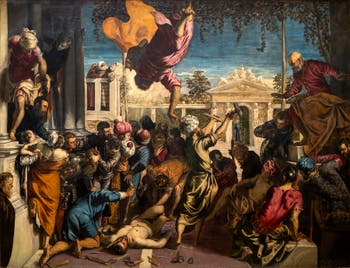
Miracle of St. Mark Tintoretto painted this picture in 1548 to illustrate a fragment of the golden legend of St. Mark, the Patron Saint of Venice: Without asking his master's permission, a slave filled with piety had gone on a pilgrimage to St. Mark to honour the relics of the Evangelist.
On his return, his master wanted to punish him in an exemplary fashion by condemning him to public execution.
He would be put to death after his eyes had been gouged out, because they had seen what they should never have seen.
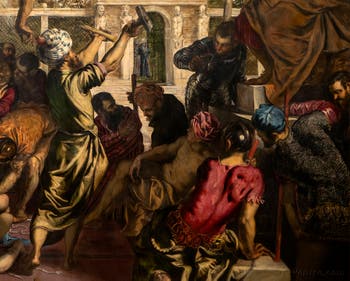
Miracle of St. Mark As the nails could not pierce the slave's eyes, the master ordered that his legs, which had carried him to Venice, be broken. But it was the axes that broke.
And as the slave continued to sing the praises of San Marco, the angry master ordered his mouth to be broken with a hammer. In vain.
So the master and all those who witnessed the miracle also made the pilgrimage to San Marco to do penance, confess and be converted.
Tintoretto's painting shows the naked slave, lying with his back to the ground, at the mercy of his tormentors, who are beating him to a pulp.
The first, on the slave's left and dressed in a blue tunic, is on all fours, turning his torso and raising his right arm to drive a stake through his eye with all his might. This is not his first attempt: the broken pieces of wood on and around the unfortunate man bear witness to this.

Miracle of St. Mark The second is at the other end, bent in half, holding his axe in his right hand and with the other hand he grabs the slave's legs to swing them to the side. He moves this body that resists the instruments of torture, turning it on its side to find a way to end it all!
The third slave, standing to his right, turns to face the master sitting up high, showing him his broken hammer. The folds in his clothing emphasise the movement and twisting of his body.
The men seated at the master's feet turn away for a moment from the spectacle of torment to note his powerlessness.
Around them, the witnesses approach, bend down, to get a closer look at this incredible thing.
Others are balanced and high up to see overhead. We turn around and shake our heads in astonishment, concern and emotion!
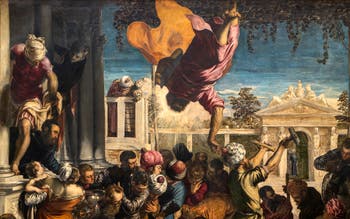
Miracle of St. Mark And no one sees St. Mark charging headfirst, right over the slave, his right hand almost touching the turban of the third executioner.
The spectator himself, busy observing what is happening around this naked man lying in the middle of the square, does not really see him until the last moment.
The viewer is as surprised and amazed as the witnesses on the spot!
With his thick book under his arm, St. Mark seems as real as the men he is preventing from acting.
This apparent mass first shows us his strength, which opposes that of the executioners; but his radiant head and the lightness of his cloak floating above him reveal that this strength is of a spiritual nature.
“Here, the colour is worthy of Titian The chiaroscuro is very strong, and the composition is treated with sobriety and accuracy.
Miracle of St. Mark The forms are chosen, the draperies studied, varied, appropriate to the subjects.
The attitudes of the men attending the show are vivid, above the imagination.
We admire that of the Saint who flies to the rescue of the slave and presents, in a way, the lightness of an aerial body.”
Stendhal - School of painting in Venice
“Never have we seen such ardour and such success of invention!
It is through this work above all that Tintoretto has earned the right to be called the Michelangelo colourist.
He was, moreover, prodigiously prolific, and spent his life filling churches with his vast decorations, sometimes hastily improvised, often verveful, always original.”
Paul Anatole Matthieu - 1901
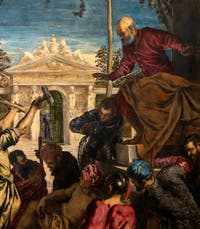
Miracle of St. Mark
“Tintoretto is the king of the violent. He has an ardour of composition, a fury of brushwork, an audacity of incredible shortcuts, and St. Mark can pass for one of his boldest and fiercest canvases.
The subject of this painting is the patron saint of Venice coming to the aid of a poor slave who was being tormented and gyrated by a barbarian master because of the poor devil's obstinate devotion to the saint.
The slave is stretched out on the ground on a cross surrounded by busy executioners, who make vain efforts to tie him to the infamous wood.
The nails snap back, the mallets break, the axes fly apart; more merciful than men, the instruments of torture grow blunt in the hands of the torturers.
Miracle of St. Mark The onlookers look at each other and whisper in astonishment, the judge leans over from the top of the court to see why his orders are not being carried out, while St. Mark, in one of the most violently strapped foreshortenings that painting has ever risked, pokes his head out of the sky and takes a plunge to earth, without clouds, without wings, without cherubs, without any of the aerostatic means ordinarily employed in paintings of sanctity, and comes to deliver the one who has had faith in him.
This vigorous, athletically muscular figure, of colossal proportions, splitting the air like a rock thrown by a catapult, produces the most singular effect.
The drawing is so powerful that the massive saint is supported by the eye and does not fall; it is a real tour de force.
Add to this that the painting is so soaring in tone, so abrupt in its oppositions of black and light, so vigorous in its localities, so harsh and turbulent in its brushstrokes, that the fiercest Caravaggio and Spaniards, set aside, would seem like rosewater, and you will have an idea of this picture which, despite its barbarities, still retains, through its accessories, that architectural, abundant and sumptuous aspect peculiar to the Venetian school.”
Théophile Gautier - Italia 1855
The Tintoretto Portraitist

The Doge Alvise Mocenigo Venetian painters used to entertain aristocrats and wealthy bourgeois who wished to leave a memento of their person and prestige by having their portrait painted.
Tintoretto had painted the portrait of the famous Véronica Franco, a courtesan and poet born in 1553, who was the mistress of the King of France during his visit to Venice in July 1574.
Veronese and Tintoretto had then decorated the triumphal arch built on the Lido by Palladio, under which Henri III was to pass.
After a stay rich in pleasures and festivities, Henri III left with the portrait offered by the belle in her memory, accompanied by two sonnets of her composition.
This portrait is currently in the United States, at the Worcester Art Museum, in Massachusetts.

Tintoretto Veronica Franco Henri III wanted to honour his talents, as he had done for the Murano glassmakers.
“He refused to be knighted by Henry III, who, passing through Venice on his way back from Poland to France, knighted several men there.”
Stendhal - School of painting in Venice
One day Tintoretto was painting a portrait of a gentleman who was a little too superficial and full of himself, and who kept telling him to render well the lace, jewels and rich fabrics with which he was dressed. Tintoretto lost patience and exclaimed:
“Go and get yourselves painted at Bassano's!”
Bassano was known as an excellent animal painter.
A group of prelates and senators had come to his studio and, seeing the speed with which he handled the brush, they told him that John Bellini and other painters were in less of a hurry and produced much more careful work.
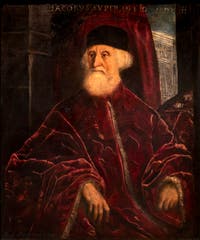
Prosecutor Jacopo Soranzo Tintoretto curtly replied:
“That may well be, as these painters are not surrounded by pesky people like you!”
This comment went unanswered... and showed the degree of freedom granted to Venetian artists, at a time when the princes and prelates of the rest of Italy greatly appreciated the flattery and praise of the artists they maintained.
These two little anecdotes show us a Tintoretto who was always criticised for his prestezza, as he drew directly with a brush, and gifted with a character too whole-hearted to bend to anyone's demands or whims.
This is hardly surprising, since he was less concerned with making a fortune than with constantly finding new commissions for the sole purpose of practising his art.
How he managed to win the competition organised by the Scuola Rocco is very revealing.
The Aretine and Sansovino judge Tintoretto
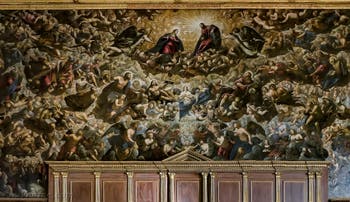
Tintoretto's Paradise Letter CLXVII fromthe Aretin to Jacopo Tintoretto: you paint too fast!
L'Arétin, a famous contemporary of Tintoretto, admired “the effect of relief” and “the colours that are flesh” of the body of the completely naked slave lying on the floor.
These colours and this plasticity are those of a living being.
He also appreciated the accuracy of the characters' attitudes and facial expressions, which give “rather an impression of reality than of painting”.
But that was not enough: if he wanted to rise to a higher degree of perfection, he would have to control the impetuosity of his youth.
If he reduced the speed of execution to the patience of realisation, his reputation would be greatly enhanced. He contrasts the prestezza del fatto of Tintoretto with the patienza di fare of the accomplished artist.

Tintoretto's Paradise Sansovino shares this opinion, speaking of the “Tintoretto whose invention is fertile, but who lacks that great patience which usually brings all things to a conclusion, and it is true that he embraces too much”.
It should be pointed out here that the Aretine, Sansovino and Vasari had taken refuge in Venice after the sack of Rome in 1527.
They were admirers of Michelangelo and Raphael.
They appreciated their figurative style, and they knew how to appreciate the artistic ideal in the perfection of contour that characterised the works of the Roman and Florentine painters.
By painting too quickly, Tintoretto could not get close enough to the Idea of Beauty in the ancient mode, which an artist strives to represent in his work. This is undoubtedly what these men of the Renaissance reproached him for.
Tintoretto's far presto
According to the Aretinian, Tintoretto's speed of execution would cause him to miss the Ideal Beauty, which requires a slow and patient search.Tintoretto's speed of execution, “far presto” was the subject of criticism and polemics about this painting.

Miracle of St. Mark Since it displeased him so much, Tintoretto unhooked it and took it back to his studio.
After a while, it was reclaimed and returned to the Scuola di San Marco.
For you only have to look closely at The Miracle of St Mark Delivering the Slave to see that this was no shoddy work.
Nothing is missing from the characters surrounding the slave: the reflections of the soldier's armour, the tassels on the jacket of the man next to him, the beards and curly hair, the patterns in the fabric of the robe of the man with the turban, everything is perfectly rendered.
The same goes for the plasticity of the bodies and the drapery; the executioner's garment showing his broken hammer is as fluid as silk.
The chromaticism is equally rich, and the painting as a whole is well constructed.
“At the back of the chapel of this Brotherhood, a slave martyred by the Turks, but delivered by St. Mark who descends on purpose from Heaven; this is Tintoretto's masterpiece for composition, colour and drawing; the heads are very well painted and in the manner of Titian, but firmer.”
Jérôme de Lalande - Journey to Italy.
Jacopo Robusti called The Tintoretto: The Venetian Colorito

Miracle of St. Mark With the Miracle of the Slave, Tintoretto had succeeded in realising the motto of his youth: the drawing of Michelangelo and the colouring of Titian, to which he added movement.
Tintoretto's way of working was no longer that of an artist imitating the ideal model he discovered in himself, to represent a stylised, stable and timeless beauty.
It was that of the Italian painters of the Renaissance, where drawing was primordial as a means of tracing the line or the contour.
The artist's idea was first developed and presented through the outline of the drawing: the shapes were fixed, then the whole was organised. Colour came next.
For them painting was, as Vasari said,
“A plane covered with flat areas of colour, arranged on the surface of a wooden panel, a wall or a canvas around lines which, by the grace of a good drawing of curved lines surround the figure.”

Miracle of St. Mark Drawing was the principle, or foundation, of architecture, sculpture and painting.
Venetian painters were first and foremost colourists, for whom contours in nature were perceptible as colours, as tones.
The line is an invention, an abstraction that does not exist in nature; as such, it is not essential for a good imitation of this nature full of nuances.
These nuances, often fleeting, can only be rendered by colours that have been prepared, worked, mixed and applied according to the rhythm and pressure of the brush at the end of an expert hand, giving them that character that is specific to the Venetian colorito (colour). The “trick of the hand” rather than the drawing!
Tintoretto's hand draws and paints in a single gesture, because he paints his picture at the same time as he conceives it: sketch and picture become one and the same work.

Arian, Venus and Bacchus Such is his prestezza di fare, his speed of realisation so astonishing, and so revolutionary in its results.
This is what he would later say to the members of the Scuola di Rocco who reproached him for providing them with a finished work instead of the sketch they had requested!
In his creative élan, he freely used all the means offered by drawing and colour: dizzying perspectival shortcuts translating exaggerated movements, light that is not what we usually see, astonishing colours, a space different from our own.
For Tintoretto not only knew how to improvise, he also had a genius for original inventions in relief and in the harmony of colours.
He did not hesitate to push the limits of technique and style, even if it meant defying the values of finish and care of a pictorial work considered to be finished!
Tintoretto Life and Career | Colors and Fame | Kings Churches Museums
Painters Tintoretto | Titian | Canaletto | Fortuny | Albrecht Dürer |
Art Painters | Music | Literature | Video | Pictures
Back to Top of Page


